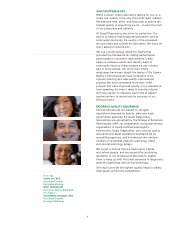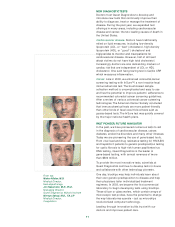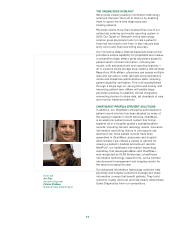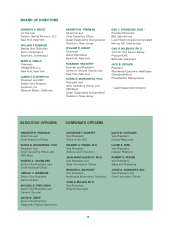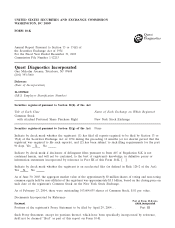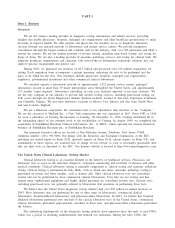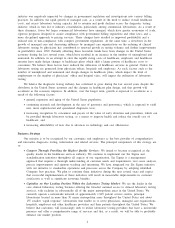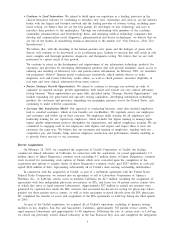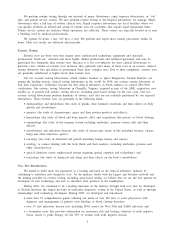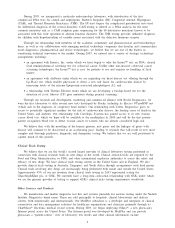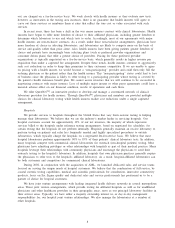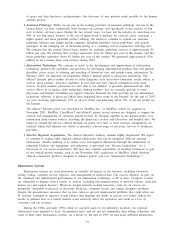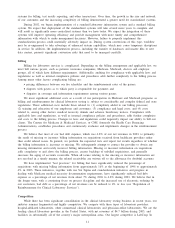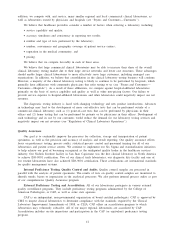Quest Diagnostics 2003 Annual Report Download - page 19
Download and view the complete annual report
Please find page 19 of the 2003 Quest Diagnostics annual report below. You can navigate through the pages in the report by either clicking on the pages listed below, or by using the keyword search tool below to find specific information within the annual report.industry was negatively impacted by changes in government regulation and investigations into various billing
practices. In addition, the rapid growth of managed care, as a result of the need to reduce overall healthcare
costs, and excess laboratory testing capacity, led to revenue and profit declines across the diagnostic testing
industry, which in turn led to industry consolidation, particularly among commercial laboratories. As a result of
these dynamics, fewer but larger commercial laboratories have emerged, which have greater economies of scale,
rigorous programs designed to assure compliance with government billing regulations and other laws, and a
more disciplined approach to pricing services. These changes have resulted in improved profitability and a
reduced risk of non-compliance with complex government regulations. At the same time, a slowdown in the
growth of managed care and decreasing influence by managed care organizations on the ordering of clinical
laboratory testing by physicians has contributed to renewed growth in testing volumes and further improvements
in profitability since 1999. Partially offsetting these favorable trends have been changes in the United States
economy during the last several years, which have resulted in an increase in the number of unemployed and
uninsured. In addition, in an attempt to slow the rapidly rising costs of healthcare, employers and healthcare
insurers have made design changes to healthcare plans which shift a larger portion of healthcare costs to
consumers. We believe these factors have reduced the utilization of healthcare services in general. Orders for
laboratory testing are generated from physician offices, hospitals and employers. As such, factors such as the
number of unemployed and uninsured and design changes in healthcare plans, which impact the level of
employment or the number of physicians’ office and hospital visits, will impact the utilization of laboratory
testing.
We believe the diagnostic testing industry has continued to grow during the last several years despite the
slowdown in the United States economy and the changes in healthcare plan design, and that growth will
accelerate as the economy improves. In addition, over the longer term, growth is expected to accelerate as a
result of the following factors:
•general expansion and aging of the United States population;
•continuing research and development in the area of genomics and proteomics, which is expected to yield
new, more sophisticated and specialized diagnostic tests;
•increasing recognition by consumers and payers of the value of early detection and prevention, which can
be provided through laboratory testing, as a means to improve health and reduce the overall cost of
healthcare; and
•increasing affordability of tests due to advances in technology and cost efficiencies.
Business Strategy
Our mission is to be recognized by our customers and employees as the best provider of comprehensive
and innovative diagnostic testing, information and related services. The principal components of this strategy are
to:
•Compete Through Providing the Highest Quality Services: We intend to become recognized as the
quality leader in the healthcare services industry. We continue to implement our Six Sigma and
standardization initiatives throughout all aspects of our organization. Six Sigma is a management
approach that requires a thorough understanding of customer needs and requirements, root cause analysis,
process improvements and rigorous tracking and measuring. We have integrated our Six Sigma initiative
with our initiative to standardize operations and processes across the Company by adopting identified
Company best practices. We plan to continue these initiatives during the next several years and expect
that successful implementation of these initiatives will result in measurable improvements in customer
satisfaction as well as significant economic benefits.
•Capitalize on Our Leading Position Within the Laboratory Testing Market: We are the leader in the
core clinical laboratory testing business offering the broadest national access to clinical laboratory testing
services, with facilities in substantially all of the major metropolitan areas in the United States. We
currently operate a nationwide network of approximately 1,925 patient service centers, principal
laboratories located in more than 30 major metropolitan areas throughout the United States and about
155 smaller “rapid response’’ laboratories that enable us to serve physicians, managed care organizations,
hospitals, employers and other healthcare providers and their patients throughout the United States. We
believe that customers will increasingly seek to utilize laboratory testing providers that have a nationwide
presence and offer a comprehensive range of services and that, as a result, we will be able to profitably
enhance our market position.
2


